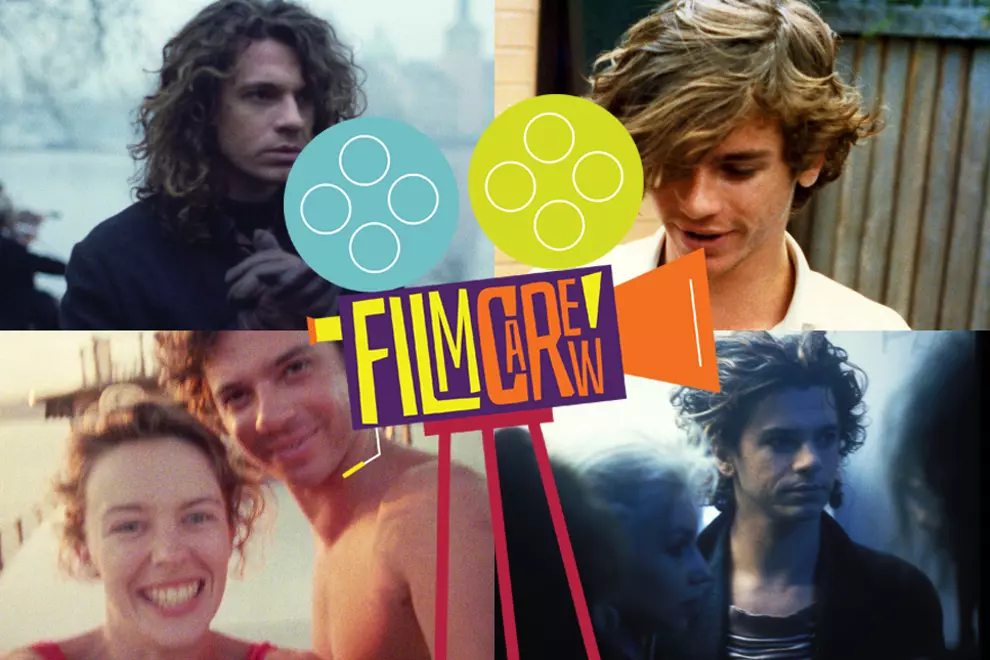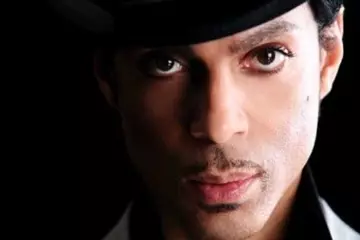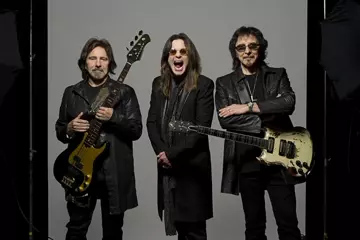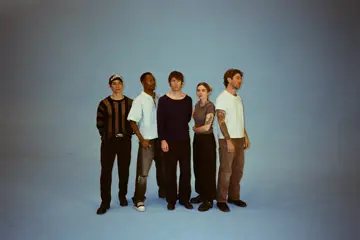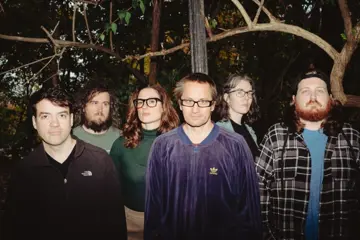MYSTIFY: MICHAEL HUTCHENCE
★★★1/2
The world was hardly clamouring for another filmed entertainment chronicling the life of late INXS frontman Michael Hutchence, but Mystify has things that set it apart from the realm of Oz TV biopics, pro forma rockumentaries, and glorified celebrity muckraking.
It’s made by Richard Lowenstein, the Melburnian director who — from making over a dozen INXS videos, through Dogs In Space and We’re Livin’ On Dog Food — has spent 35 years ensconced in the world of Hutchence, on screen and off. This means that the doc has great access: not just to interviewees, but archival footage, family photo albums, and incredibly intimate home videos shot by Hutchence himself.
Lowenstein also makes a simple decision that sets Mystify apart from the standard rockumentary: he interviews all manner of familiar figures — ex lovers, managers, publicists, bandmates, Bono — but keeps only their voices. Instead of talking heads, all sat in front of some school photo day backdrop, we hear their words, which are then overlaid upon footage of Hutchence, be it promotional or personal, on stage or backstage, in an INXS video clip or frolicking on European vacation with Kylie Minogue.
Don't miss a beat with our FREE daily newsletter
It’s the Minogue sequences that will garner the most interest for Mystify, due to the celebrity lure, and the nature of online clicks/gossip. But they’re also some of the most telling moments in the movie, a great insight into Hutchence as human being. As interviewee, Minogue is astonishingly candid, effectively letting viewers into the intimate space of a previously-unknown relationship. And her recollections of their time together are set against home video travel footage largely shot by Hutchence, which takes in hotel rooms, cars, trains, roads, piazzas, lavender fields; the whole given an artful, almost eerie air by the evocations of Hutchence’s then-obsession with Patrick Süskind’s Perfume: The Story Of A Murderer.
The book haunts the narrative in Hutchence’s later, darker, downward spiral years, when a drunken confrontation with Dutch taxi driver left the frontman with a fractured skull, a traumatic brain injury, the loss of taste and smell, and a loss of his identity. Thereafter, he was depressed and drug abusing, entering into a precipitous decline that would end with his 1997 death.
As with so many rock’n’roll tales on screen — be they dramatised or documentarised — there’s grand contrast between the artist at the peak of their powers and them at their lowest ebb. Mystify gladly avoids pushing too hard in either direction. Whilst his music, and his charisma, is oft-praised, Lowenstein, as friend of the subject, is never going to submit to some heroising hagiography. And, in turn, he’s not interested in performing some post-hoc autopsy on what went wrong, digging deep into the dark mire of Hutchence’s last days. Instead, the attempt is to do something that so few rockumentaries even try: making a picture that’s just as poetic as the music it’s historicising.
HAIL SATAN?
★★★1/2
As someone saddened by the erasure of punctuation from film titles, it’s great to see a punctuation as loaded as the lingering question-mark in Hail Satan?. It’s a documentary on America’s Satanic Temple, in which we soon discover that Satan isn’t really being hailed. Instead, this religious collective is essentially a front for a grassroots activist organisation, who essentially polices the division between church and state in an increasingly-evangelical America; out to battle “the theocratic stranglehold” that Christianity has on politics, policy, and morality. Their various performance art-esque media stunts are out to teach “civics lessons” to the politicians who take their Christian beliefs as an unassailable norm. The Temple’s most famous stunt was petitioning to erect a 2.6m statue of a goat-headed baphomet outside the Oklahoma state capitol; which, they argued, was only fair given that a 10 Commandments monument had just been erected.
Director Penny Lane — who dug into the covert recording Nixon archives for Our Nixon and animated the grand quackery and swindles of John Brinkley with Nuts! (another punctuation mark!) — assembles Hail Satan? as feelgood documentary, a comedy chronicling a band of misfits confronting the hypocrisy of the status quo with plentiful absurdity, impish rebellion, and good old fashioned trolling.
There’s some dives back into history (the rise of the evangelical lobby in the red scare of the 1950s; the tracing of 10 Commandment monuments back to Paramount promotion for Cecil B DeMille film in 1956; the Satanic Panic re: heavy metal and D&D in the 1980s), some heartening sequences of Satanists at charity work (tampon drives, highway and beach clean-ups), and a bubbling sense of community building. But, really, it’s a film built around a host of hilarious stunts, and the mischievous folk who plan them. At a time of increased political conservatism and retrograde religious lobbying, Hail Satan? is genuinely heartening.
THE THIRD WIFE
★★★★
There’s shades of auteurs like Hou Hsiao-hsien and Tran Anh-hung in this Vietnamese period piece, which is so lovingly shot, so full of lingering silences, so evocative of both the tactile and the ineffable, so filled with out of focus objects lingering in the foreground of the frame, that it begs old standby film-crit descriptors like ‘sumptuous’ and ‘sensuous’. Ash Mayfair — Vietnamese-born, Australian-schooled, New York-based — makes a striking debut, luring viewers into a beautifully photographed world whose aesthetic seductiveness obscures the sting in the narrative; something that echoes the journey of its titular character.
Mayfair mines her own family history, dramatising something that happened to her own great grandmother: being sold into an arranged marriage, at 13 years old, in the 19th century. Screen debutante Nguyen Phuong Tra My — making quite the first performance — plays a child bride who arrives, as the third spouse of a wealthy land owner. A poor, naïve rural girl, she’s less stepping into a grand family home, more stepping into a whole new world, one in which her innocence will soon be lost.
The cloistered house is a world unto itself, full of unknown mysteries; about adulthood, sexuality, and family dynamics. Slowly, our third wife must learn to navigate this web of family relationships, which are perilous, sometimes incestuous. Mayfair shoots the whole thing as taking place in a glowing, sublime idyll, and this aesthetic dreaminess is at once glorious to bask in and a sly commentary on period-piece romanticism. Here, entrenched patriarchal systems — in which women are seen as veritable commodities to be traded, vessels for sexual pleasure and child bearing — underpin every stroll through a glorious garden or lingering shot of a woman’s stray strands of hair blowing in the breeze. The Third Wife is a beautiful portrait of a horrifying scenario.
A WHITE, WHITE DAY
★★★★
The premise for A White, White Day sounds familiar: in a remote community, a grizzled, hard bitten, lone wolf police officer, on leave following the death of his wife, discovers that she was having an affair, and grows increasingly obsessed — and unhinged — with the man she was sleeping with. Cue: a cop who doesn’t play by the book, a downward spiral, an act of violence, a grim study of the codes of masculinity. But, whilst this synopsis isn’t an inaccurate summation of Hlynur Pálmason’s picture, it certainly doesn’t capture what it’s about. Not just in the fact that A White, White Day is actually an exercise in slowly-mounting existential dread. But, in the fact that it’s most notable as a work of fastidiously-precise framing, a minimalist masterwork that’s a (quiet) riot for composition nerds.
That starts with an astonishing opening sequence: in which a host of static tableaux look at renovation works on a lonesome house on the remote Icelandic shoreline; the seasons passing — snow falling, mist swelling, landscape changing — across five wordless, plotless minutes. Once we move inside the house — a place being completely renovated by our on-leave cop, Ingvar Eggert Sigurðsson — Pálmason continues his fondness for matching compositions: anytime we look out a round porthole window at the front drive, or out over the back deck towards the sea, the framing is identical to the last shot from the vantage, no matter how much time has elapsed between edits.
The result is a film that creates a frisson by marrying frosty formalism to a few moments of grand drama or shocking violence. Whilst there’s some video-fetishing sequences of oddball low res amateurism (home videos shot on a camcorder, a hysterical children’s program about a deep space apocalypse), Pálmason only employs them as interjections to a film that, otherwise, shows almost ascetic restraint.
The director largely uses only available light sources: there moments of disorientation, and tension, when we’re plunged into darkness; his Iceland one in which the skies are hanging low and grey; A White, White Day taking its name from folkloric Icelandic belief that, on days where the foggy landscape obliterates the gap between land and sky, you can commune with the dead. In turn, it’s a film whose elusive, mysterious nature hints at the ineffable; there much contemplation to be had in what’s happening both within, and outside of, its static frames.

